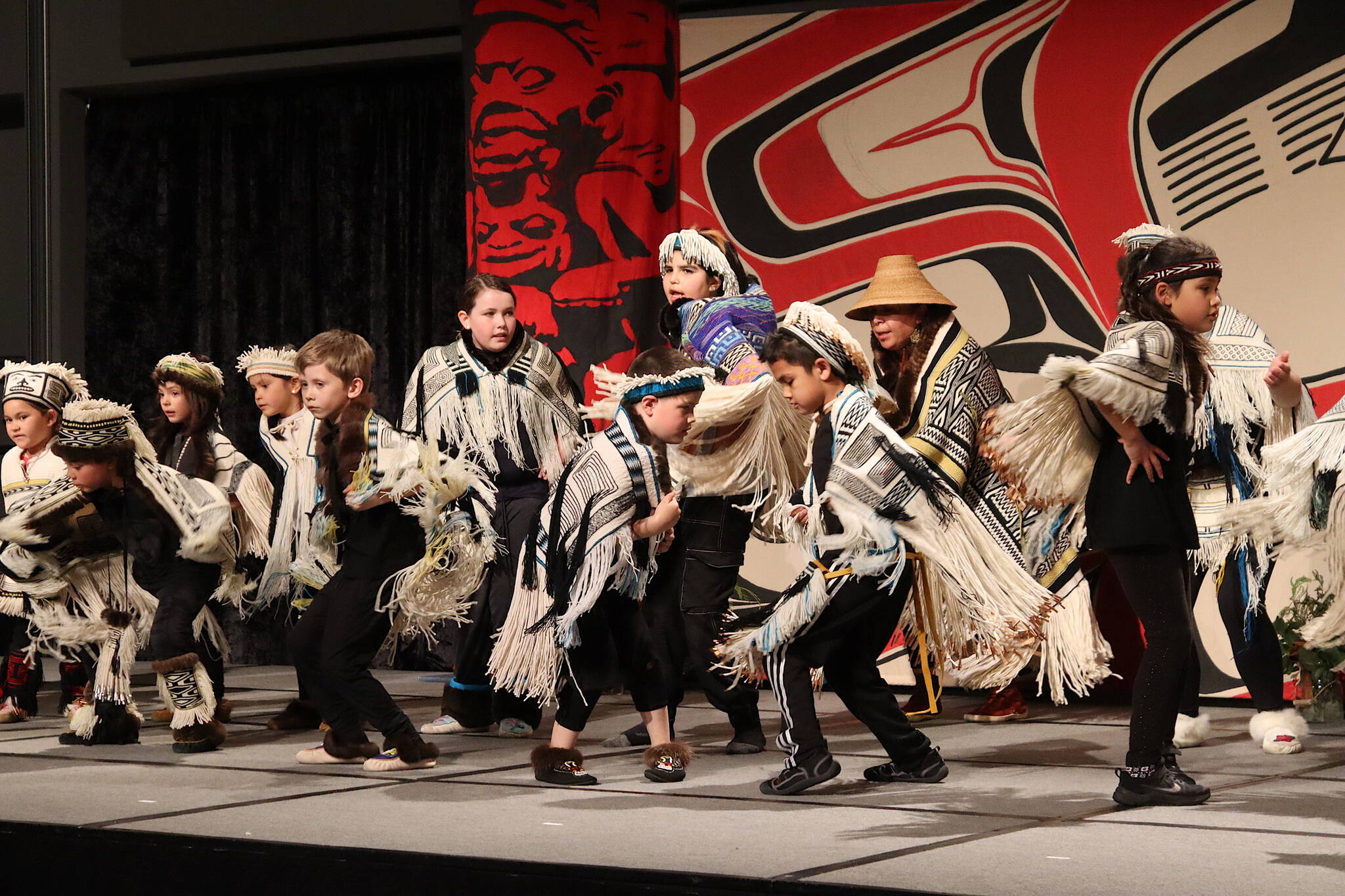Aurora Koal.a,Gisook Southerland says knowing the dances for a historical event Tuesday was easy enough thanks to her cultural schooling, but there was something of a fringe element to the robe she was wearing that made things a bit shaky.
“Usually in traditional Tlingit blankets they don’t have fringe so you just slowly dance, but these you have to like shake your shoulders,” she said, referring to the dense rows of woven strands along the robe’s edges.
Southerland, 11, a student and drummer in the Juneau School District’s Tlingit Culture, Language, and Literacy (TCLL) program, was among about 20 youths — and 50 people in total — in what was described as “the largest gathering of Ravenstail regalia in history” Tuesday night at Centennial Hall. She was wearing a robe with a rainbow of bright-striped colors across the front and a collage of modern patterns on the back that she said was also a departure from her traditional experiences.
“Traditionally you didn’t have a lot of these bright colors, so I think it’s really cool that this uses a lot of bright colors,” she said. “On the back it kind of looks like the northern lights.”
The event titled “History & Future of Yeil Koowú, Ravenstail Weaving” featured newly made child-sized robes by weavers trained in the technique from all over North America, most worn and danced in for the first time during the evening. The event was organized by Lily Hope, a longtime local artist who has crafted Ravenstail weavings for more than a decade and taught many of the people contributing regalia for the performance.
Hope described the child-size robes she sought from students as “a collection of short stories” — and some of the storytellers were still finishing those narratives during a weavers’ gathering in the lobby of Centennial Hall a few hours before the show.
“I’m an herbalist so it’s a focus on wild plants and the whole ensemble is called ‘Wild Child,’” said Annemarie Hasskamp, a Skagway resident putting the finishing touches on a white robe featuring a row of black “treasure boxes” containing “different colors representing wild plants from the forest.” Spanning the robe above and below the boxes were wide, wavy strips in blue, black and white.
Presenting a history of Ravenstail techniques during the evening ceremony was Ruth Hallows, a Ksm Lx’sg̱a̱n weaver and teacher currently living in Arizona, who said the weavings originated from people indigenous to the river and coastal waterways of Southeast Alaska and northwest British Columbia. But the presence of the weaving diminished after the 19th century in favor of newer weaving techniques.
“This art form slept for nearly 200 years,” she said. “We have access to few examples of robes, and little of its protocols, meanings and historical uses.”
Credited with reviving Ravenstail weaving is Cheryl Samuel, a researcher and fiber artist who during the 1970s discovered it while studying Chilkat dancing blankets, a technique literally intertwined with Ravenstail weaving, Hallows said. In reviving the craft, weavers have made adoptions including the use of wool from merino sheep rather than traditional mountain goats due to a decline in their population.
Samuel was honored as a modern pioneer of the craft during Tuesday evening’s event along with Kay Field Parker, a student of Samuel’s who became a notorious teacher of her own. Parker, in a speech paying tribute to Samuel, talked about an early experience with her during a 1990 trip to the Ketchikan Totem Heritage Center where five teachers and 40 weavers spent a week “getting to know each other and sharing the art form.”
“With Cheryl’s guidance we started a robe which traveled to the member communities, with each group weaving a pattern and sending it on to another group,” Parker said. “Cheryl Samuel graphed a new pattern called ‘all weavers intertwined,’ which is the top and bottom border of this robe known as the Mother Robe. And as the weeks progressed and the weavings developed we became captivated, and weaving became a habit that became a lifestyle. And so it began.”
The dancing of the robes started with the TCLL students, who after an entrance and stage dance were joined by the adults for the six-song performance for the in-person audience of hundreds and people watching a livestream produced by KTOO.
“You have just witnessed the largest gathering of Ravenstail regalia in history,” Hope said before the dancers gave their exit performance.
But she noted additional events are planned, beginning with some of the regalia featured Tuesday being displayed at the Juneau-Douglas City Museum in an exhibit titled “Yeilk’: Ravenstail Regalia for Our Future Clan Leaders” starting Friday. Beyond that — and perhaps on a larger scale than Tuesday’s ceremony — is an inaugural Northwest Coast weavers symposium in June of 2026.
The symposium is “a three-day affair culminating in a gathering of the robes — a joining of all culturally owned Chilkat, Ravenstail and Cedar Bark regalia dancing together,” Hope said.
After being presented with a bouquet and getting a standing ovation from the crowd in a farewell tribute to her after the announcement, she closed out the show by telling the crowd “thank you for making magic — let’s do it bigger in two years.”
• Contact Mark Sabbatini at mark.sabbatini@juneauempire.com or (907) 957-2306.

